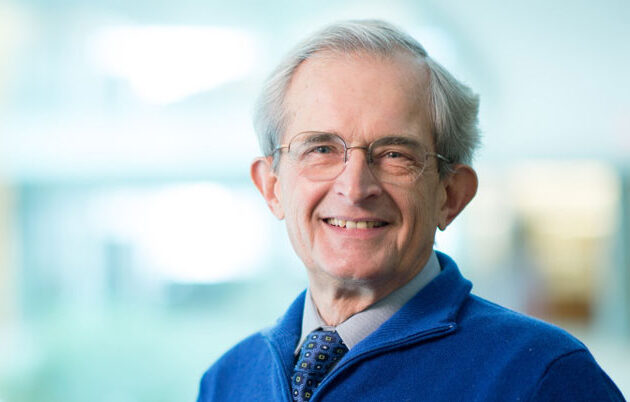In 2023, Galipeau was nominated for a Wisconsin Alumni Research Foundation (WARF) Innovation Award for his partnership with Dr. Mahua Dey on a personalized therapeutic cancer vaccine to treat glioblastoma — one of the deadliest forms of cancer. WARF, which serves as the technology transfer office for UW–Madison, has supported faculty across the UW School of Medicine and Public Health through grants, research facilities, and the patenting and licensing of breakthroughs that have benefited the world.
How do you describe your role with PACT?
As the director of PACT, I lead a multidisciplinary team striving to help develop and deploy personalized cell therapies to treat intractable health conditions and diseases long thought to be incurable. In addition to supporting first-in-human clinical trials and facilitating Food and Drug Administration (FDA) approval for therapies shown to be safe, we also enable a vibrant pipeline of experimental pre-clinical research. We have on-going clinical trials addressing the vexing problem of xerostomia (dry mouth), which afflicts throat cancer survivors who received radiation treatment to their neck as well as patients with graft versus host disease (in which a transplant patient experiences an attack on tissues or organs from their donor’s immune cells). We are working with UW research teams to engineer cells that will kill cancer cells or prevent autoimmune reactions from destroying the body. In the pipeline, we have experimental research into cures for glioblastoma, pancreatic and ovarian cancer, childhood neuroblastoma, graft versus host disease, multiple sclerosis, diabetes and many others.
Where do the cells for these therapies come from?
The clinical research cells may come from the patient or a transplant donor. The research teams we work with are manipulating cells to change their identity — their functional characteristics — so they can fight disease more effectively. To cure cancer, to reverse autoimmune disease, you have to break the rules of Mother Nature.
How do you describe PACT’s work?
I ask people to imagine us as a hospital-embedded therapeutics biotech startup. We can take a therapeutic platform through research and development, clinical trial, FDA approval and deployment.
Academic medical centers don’t have the infrastructure to manufacture small molecules and biologics, which is the medicinal chemistry needed to create drugs. For that, you need drug companies. But cell therapy is different.
UW has been a leader in cell therapy since 1968, when Fritz Bach, MD, performed a successful bone marrow transplant on a 22-month-old boy with Wiskott-Aldrich Syndrome, a rare genetic immunodeficiency. The transplantation of bone marrow cells from donor to recipient is considered medical practice and is not subject to FDA approval. But if you manipulate the cells in the lab, which is the latest frontier in immune-based therapy, then FDA approval is required.
Thanks to our long history of bone marrow transplant, we had the infrastructure and expertise to create an FDA-compliant PACT. Our program can speed the time from bench to bedside, allowing us to validate UW cell therapy innovations within our organization and accelerating the pathway to FDA approval.
What does this startup look like?
A hospital-embedded startup like ours needs four key things. Number one, a vibrant research program, with creative UW scientists running experiments on experimental animal systems (this helps us see what is coming tomorrow, even as we are developing therapies for today). Number two, access to high-performance clinical trial teams with nationally ranked expertise in patient care. UW has plenty of those and we tap into that talent pool. Number three, the ability to manufacture cell therapy on site, which we can do at our PACT facilities located within University Hospital. We have an FDA-compliant, pharmaceutical-grade cleanroom, a quality control laboratory, and cryopreservation capabilities staffed by a crack team of mission-focused manufacturing professionals. Finally, you need regulatory expertise on staff to oversee rigorous administrative FDA compliance.
How long does it take to achieve compliance with FDA regulations?
PACT was launched in 2016, and we received our first Investigational New Drug (IND) authorization — which is an FDA-issued license to deliver an investigational product to a patient in a first-in-human trial — in 2020. This was for a new cell therapy to treat life-threatening viral infections in bone marrow transplant patients. Since then, we have secured eight such FDA licenses in as many innovative human studies, all conducted at UW.
We look at the big picture and consider: What’s currently in a national clinical trial? What is “clinic-adjacent,” meaning therapies that will soon be at the trial stage? What research is in the pipeline but is two to three years away from a clinical trial? An example of a cell therapy currently in trial is the first-in-human treatment of a Sjögren’s disease patient, where Dr. Sara McCoy is using the patient’s stem cells to prevent dry mouth, a common symptom of the disease. An example of therapies at the clinic-adjacent stage are those using stem cells to treat advanced pancreatic cancer and ovarian cancer. And then there’s the pipeline — what I call the “mouse stuff” — where, for example, we are exploring the use of patients’ B cells to treat multiple sclerosis.
Could cell therapy replace drugs?
For certain use cases, yes. For certain disorders like diabetes, for example, if you can replace the missing pancreatic cells that make insulin, you don’t need to take insulin drugs anymore. CAR T-cell therapy is a specialized type of immunotherapy that uses a patient’s genetically modified T-cells to fight cancer. Just over a decade ago, the first pediatric patient was cured of B-cell acute lymphoblastic leukemia using CAR T-cell therapy. That really opened everyone’s eyes, both in the industry and in academic medicine — it showed that if done creatively, cells can serve as an engine to cure the incurable.
What is your vision for PACT over the next decade?
Our big vision is to establish a local pipeline of commercially viable cell therapy that addresses important unmet medical needs through a stable of “new co’s” (the term is industry shorthand for a new company created to deploy, at scale, innovative technologies developed within our research institution). As a private, for-profit business entity, the new company can attract venture philanthropy and business funding partners, which are needed to capitalize the scaling up of production and implementation as we move through the scientific process of clinical trials to generate proof of efficacy. After the technology has been developed at UW and transferred to a new company, the ultimate goal is to secure drug product FDA approval to make our products eligible for insurance and Medicare/Medicaid coverage, and therefore accessible to the general Wisconsin population and beyond. The embodiment of the Wisconsin Idea!
What are you most excited about in the research pipeline?
There are many, but one in particular is very exciting. Currently, no cure exists for Type 1 or Type 2 diabetes, in which the endocrine “islet” cells in the pancreas do not produce enough insulin. WiCELL, a cell bank established to advance the work of UW researcher James Thompson, makes available FDA-approved human embryonic stem (ES) cell lines that were initially developed by Thompson’s team in the 1990s. Working with our world-class UW pancreas transplant team, led by Jon Odorico, we are genetically engineering synthetic pancreas cells from those cell lines that can be used in all patients without need for anti-rejection drugs. The goal is to restore pancreatic function and cure diabetes, while preventing immune rejection. We are still in the pipeline stage, but theoretically, this work could make it possible to cure diabetes with manufactured ES cells. This would be a one-size-fits-all cure with no side effects. That is the potential breakthrough, built upon a seminal UW discovery.
This is long-term work. How do you stay positive in the face of setbacks?
The correct answer to any question is never “no.” It’s more like, “Let’s think through this, over it, under it, alongside it.” People who can spot problems are 13 to the dozen. People who can come up with creative remedies are rare birds. I really like to reflect on creative remedies, whether organizational, scientific or operational — and that involves drawing outside the lines. That is what gets me up at three in the morning and what I think about in the shower. I love working with smart, mission-driven people, and there are lots of smart, driven people at UW.
Why is UW–Madison a great place to be?
For one thing, we are ranked #6 in the U.S. in Higher Education Research and Development rankings compiled by the National Science Foundation. UW is a brain trust powerhouse. There is also a critical mass of scholars who have shared scientific and translational interests, particularly in cell and gene therapy. For me, that means friends for the sandbox! Last but not least, what a great place to live! I’m looking at Lake Mendota from my office window right now and love taking a stroll on the Howard Temin path towards Memorial Union. Temin was a UW scientist who received the 1975 Nobel Prize in Medicine for his discovery of an enzyme called reverse transcriptase that helps certain viruses hijack a healthy cell. I am hoping to absorb some of his vibe! From a work/life/creativity perspective, Madison is fantastic.
Banner image of Jacques Galipeau by Todd Brown, Media Solutions


